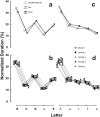Children's first handwriting productions show a rhythmic structure
- PMID: 28717141
- PMCID: PMC5514070
- DOI: 10.1038/s41598-017-05105-6
Children's first handwriting productions show a rhythmic structure
Erratum in
-
Author Correction: Children's first handwriting productions show a rhythmic structure.Sci Rep. 2018 Mar 15;8(1):4874. doi: 10.1038/s41598-018-23228-2. Sci Rep. 2018. PMID: 29545569 Free PMC article.
Abstract
Although much research has been concerned with the development of kinematic aspects of handwriting, little is known about the development along with age of two principles that govern its rhythmic organization: Homothety and Isochrony. Homothety states that the ratio between the durations of the single motor events composing a motor act remains invariant and independent from the total duration of the movement. Isochrony refers to the proportional relationship between the speed of movement execution and the length of its trajectory. The current study shows that children comply with both principles since their first grade of primary school. The precocious adherence to these principles suggests that an internal representation of the rhythm of handwriting is available before the age in which handwriting is performed automatically. Overall, these findings suggest that despite being a cultural acquisition, handwriting appears to be shaped by more general constraints on the timing planning of the movements.
Conflict of interest statement
The authors declare that they have no competing interests.
Figures



References
-
- Dehaene, S. Reading in the brain: The new science of how we read (Penguin, 2009).
Publication types
MeSH terms
LinkOut - more resources
Full Text Sources
Other Literature Sources

